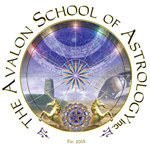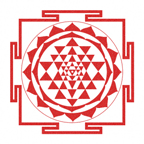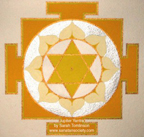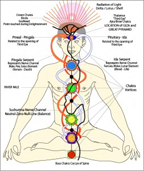
AVALON
SCHOOL OF ASTROLOGY
A VOCATIONAL ASTROLOGY SCHOOL
Located in Sunny and Beautiful
Gainesville, FL, USA
www.AvalonAstrology.com
E-mail: avalon@avalonastrology.com
Licensed by the Commission for Independent Education, Florida Department of Education, License #2858

DAVE MOCKAITIS Dave is a professional astrologer that holds a diploma in Theoretical and Applied Cosmic Cybernetics (TACC), a four years program at the Avalon School of Astrology. He is also a professional graphic artist and web designer.
|
| Students & Alumni Corner | ||||||||||||||||||||||||||||||||||||
CONTACTING
THE PLANETS
|
||||||||||||||||||||||||||||||||||||
| Chakra | Color | Anatomy, Gland | Symbolism |
|---|---|---|---|
| 1: Muladhara | Red | Perineum, Adrenals | Grounding |
| 2: Svadhisthana | Orange | Sacrum, Genitals | Sexuality |
| 3: Manipura | Yellow | Solar Plexus, Pancreas | Will |
| 4: Anahata | Green | Heart, Thymus | Love |
| 5: Vissudha | Blue | Throat, Thyroid | Communication |
| 6: Ajna | Indigo | Brow, Pineal | Intuition |
| 7: Sahasrara | Violet | Top of Head, Pituitary | Understanding |
| (Source: Judith 42-45) | |||
It’s not a huge conceptual leap from understanding the chakras as spinning spheres to corresponding the chakras with the seven visible planets of the ancients, but contemporary chakra theorists disagree about how exactly to map the solar system onto this esoteric anatomy. Contemporary knowledge errs on the side of modern psychological astrology, corresponding the chakras with the modern planetary rulerships of signs that seem to connect thematically. So Pluto, which rules Scorpio in modern psychological astrology, is correlated with the second chakra of sexuality because of Scorpio’s association with sex and genitals (About “Astrochakras”). The most ancient chakra associations, though, presents a more streamlined and elegant ordered system.
In "A Beginner’s Guide to Constructing the Universe", Michael Schneider presents a Renaissance-era-inspired depiction of the chakras and their planetary correspondences (261). Beginning at the base of the spine with the first chakra, which is associated with Saturn, the chakras proceed in Chaldean order which is synonymous with the relative planetary distances from the Sun (Saturn – 1, Jupiter – 2, Mars – 3, Venus – 4, Mercury – 5, Moon – 6, Sun – 7) (Warnock Planetary Hours). It’s quite likely that this is the progression that was used by the ancients as it resonates so clearly with other planetary systems in use at the time.
Anodea Judith, Ph.D., is one of the most outspoken proponents of the Chakra System. A somatic therapist, counselor, yoga teacher, and workshop leader, her work engages the chakras at an experiential, yet academic level. Her groundbreaking 1987 work, Wheels of Life: A User’s Guide to the Chakra System, is a seminal text in the canon of contemporary metaphysical scholarship on the chakras. Judith cites the Atharvaveda as the earliest written text exploring the esoteric anatomy comprised by the chakras.
Amongst other things, the Atharvaveda is a creation story, telling the myth of how cosmos and humanity were created through the work of a divine energy source. Human anatomy and cosmology are intertwined in the text, clearly demonstrating a powerful interrelationship between the two, like the Hermetic and Neoplatonic doctrines, life emanates from one source and physical realities on earth resonate with the astronomical bodies of the solar system. Like the book of Genesis, it is a text describing how the universe was created in seven days and how Purusha, the eternal soul embodied within the self contains seven corresponding energies. An oral tradition, finally written down between the 10th and 12th centuries BCE, the Atharvaveda informs the Upanishads, a cornerstone of Hindu Philosophy (Atharvaveda, Judith, Upanishads).
The Atharvaveda figures prominently in Vedic astrology. In their work, Light on Life: An Introduction to the Astrology of India, Vedic astrologer Hart de Fouw and Ayurvedic practitioner Robert Svoboda claim that the Atharvaveda is a primary source for both Tantra and Ayurveda (de Fouw & Svoboda 18). Ayurveda, literally “the science of life” is a system of traditional medicine in India that has reached widespread prominence in Western holistic healing circles (Ayurveda).
Like Humorism, the Hellenistic Hippocratic theory of Empedocles which describes the composition of the human body and cosmos in terms of hot, cold, wet, and dry; Ayurveda purports that there are a number of substances in the body that must be balanced for the native to live a whole, healthy life (Humorism, Ayurveda). Working to bring these regulatory systems, or doshas, into balance through diet and physical practices is the goal of the Ayurvedic practitioner.
Tantra also describes a set of practices and beliefs, though these are frequently more grounded in esoteric thought and action. In Tantra, the practitioner seeks to “ritually appropriate and channel the divine energy of the Godhead that creates and maintains the universe within the human microcosm in creative and emancipatory ways” (Tantra). Again, like the Hermetic doctrine of the Hellenistic period, though predating it by hundreds if not thousands of years, we see an identification of the microcosm with the macrocosm. It is the alignment of the two that brings about change, liberation, and wholeness within the individual.
 A key technique
within the body of Tantric technique is the use of yantra,
geometrical designs which are symbolic diagrams
that frequently depict forces at work in the universe. Broadly
defined, yantra can be thought of as any instrument with structure
and organization
that can balance the mind or help it focus upon spiritual concepts
(Yantra). Wearing, constructing, enacting, or concentrating upon
a particular yantra is thought to create spiritual and magical
benefits. Frequently, the images contained in yantras depict the
astronomical
position of planets over a given date and time and are in fact
created
at astrologically auspicious moments according to procedures
indicated in the Vedas. Concentrating or focusing upon the
images in fact is
thought to help build fortunes and bring the individual into
closer alignment with the planetary forces depicted in the
yantra (Yantra).
It is a process nearly identical to the construction of astrological
talismans in Medieval times. It’s quite significant, then, that
a dominant motif in the art historry of the yantra is the chakra
depicted as a lotus flower.
A key technique
within the body of Tantric technique is the use of yantra,
geometrical designs which are symbolic diagrams
that frequently depict forces at work in the universe. Broadly
defined, yantra can be thought of as any instrument with structure
and organization
that can balance the mind or help it focus upon spiritual concepts
(Yantra). Wearing, constructing, enacting, or concentrating upon
a particular yantra is thought to create spiritual and magical
benefits. Frequently, the images contained in yantras depict the
astronomical
position of planets over a given date and time and are in fact
created
at astrologically auspicious moments according to procedures
indicated in the Vedas. Concentrating or focusing upon the
images in fact is
thought to help build fortunes and bring the individual into
closer alignment with the planetary forces depicted in the
yantra (Yantra).
It is a process nearly identical to the construction of astrological
talismans in Medieval times. It’s quite significant, then, that
a dominant motif in the art historry of the yantra is the chakra
depicted as a lotus flower.
It becomes clear then, that the esoteric practices of the ancient Vedic cultures is significantly similar to the magic practiced by Mesopotamian descendants most clearly collected in the Picatrix, considered to be the most thorough collection of Arabic magic (Picatrix). Primarily a handbook on talismanic magic, the book also serves as a compilation of Arabic texts on hermeticism, astrology, alchemy and magic in the 9th and 10th centuries (Picatrix). In addition to a number of guidelines for talismans, the Atharvaveda also contains a number of charms and spells that clearly resonate with the instructions laid out in the Picatrix. In the same text that describes the creation of the universe, there are a number of tutorials on how to create various charms “against witchcraft; to secure long life, health, prosperity and fame; and to overthrow a rival” (Hymns of the Atharvaveda). The Picatrix contains similar invocations, for both malefic and benefic purposes (Picatrix, Warnock). Though the texts are separated by more than a thousand years and nearly a continent, the similarities are significant enough to warrant a search for an even more primary set of beliefs and practices.
The common ancestor of both the Picatrix and the Atharvaveda may be found in the mythology and culture of the Proto-Indo-European social groupings that are thought to have been in their prime around 4,000 BCE. Although there is a dearth of written texts from these groups, linguists have reconstructed significant portions of their language and mythology that bear striking resemblances to the modes of thought are depicted so clearly in these ancient texts. A group of people typically identified through linguistic commonalities, the Proto-Indo-Europeans are thought to be comprised of nomadic tribes roaming between current-day Russia, Europe, Turkey, and even further. DNA testing of skeletal remains confirms that this huge swath of territory was traversed by peoples sharing similar language and mythological beliefs (Proto-Indo-Europeans). In fact, in histories of Vedic cosmology, an invading Indo-European Aryan tribe is frequently cited as entering India in the second millennium BCE. It is even posited that these Aryans arrived on chariots and that the wheels on the chariots are what was first referred to by the term “chakra” (Judith 9). It is possible then, that the magical theories of the Atharvaveda, The Picatrix and Thabit Ibn Qurra’s work, De Imaginibus (“On Images”), the primary source text for the, all come from a culture or group of culture that predates these texts by many years.
 Reconstructing
the Proto-Indo-European culture is largely dependent on noting
linguistic similarities between various recovered
texts. As most of these texts are mythological and cosmological,
it’s
interesting to see how these ideas have migrated into the Vedic and
Western esoteric traditions. Mythological similarities appear repeatedly
and are taken up in later works by the Vedic and Hellenistic practitioners
in a variety of forms. Some of the key aspects of this symbol system
include repeating and divergent references to a chief sky god, a striker
warrior god, a love goddess, a masculine god, and rites of worship
for the sun and moon. From an astrological perspective, we can clearly
see this as representative of Jupiter, Saturn, Venus, Mars, Sun and
Moon, respectively. A
recurrence of myths regarding divine twins may speak to an understanding
of Mercury,
though there the correspondence
is not as direct. Furthermore, like the Stoics and Neoplatonists,
the Proto-Indo-Europeans consistently reference the notion
that the earth
is a living body. One creation myth depicts the earth being
formed from the body of a giant, whose “bones are the rocks, his blood
made the rivers and the seas” (Proto-Indo-European religion).
It may in fact be this notion of rocks as bones that invigorated
the Vedic doctrine of remedial measures which prescribes the
use of rocks
and precious gems as a technique for harnessing the powers
of the planets. Given the idea that the universe is a living body,
of
which the individual
is a microcosm; it stands to reason that making contact with
the remnants of the larger macrocosmic body or an intermediate
step in the chain
between the individual and the cosmos, could cause a change
in the body of the microcosmic individual or bring it into closer
harmony
with the source of all life.
Reconstructing
the Proto-Indo-European culture is largely dependent on noting
linguistic similarities between various recovered
texts. As most of these texts are mythological and cosmological,
it’s
interesting to see how these ideas have migrated into the Vedic and
Western esoteric traditions. Mythological similarities appear repeatedly
and are taken up in later works by the Vedic and Hellenistic practitioners
in a variety of forms. Some of the key aspects of this symbol system
include repeating and divergent references to a chief sky god, a striker
warrior god, a love goddess, a masculine god, and rites of worship
for the sun and moon. From an astrological perspective, we can clearly
see this as representative of Jupiter, Saturn, Venus, Mars, Sun and
Moon, respectively. A
recurrence of myths regarding divine twins may speak to an understanding
of Mercury,
though there the correspondence
is not as direct. Furthermore, like the Stoics and Neoplatonists,
the Proto-Indo-Europeans consistently reference the notion
that the earth
is a living body. One creation myth depicts the earth being
formed from the body of a giant, whose “bones are the rocks, his blood
made the rivers and the seas” (Proto-Indo-European religion).
It may in fact be this notion of rocks as bones that invigorated
the Vedic doctrine of remedial measures which prescribes the
use of rocks
and precious gems as a technique for harnessing the powers
of the planets. Given the idea that the universe is a living body,
of
which the individual
is a microcosm; it stands to reason that making contact with
the remnants of the larger macrocosmic body or an intermediate
step in the chain
between the individual and the cosmos, could cause a change
in the body of the microcosmic individual or bring it into closer
harmony
with the source of all life.
After reviewing the literature, it is clear that individuals have been propitiating the planets for thousands of years. Our current interpretations of the planets is rooted in Proto-Indo-European mythologies that predate the Mesopotamian stargazers. Though various systems and traditions have developed a variety of techniques for making contact with the seven planetary bodies visible to the ancients, they all share the common belief that the individual is a microcosm that reflects the cosmos and that direct links can be forged between an individual body and a larger, divine whole. Working with the chakra system is an ancient way of connecting with the planets that predates the widespread use of astrological and hermetic magic. Recognized as a Hindu technique, it may in fact reach further back in time to the cultures that have left behind no physical remains. In constructing a cohesive history of astrology, we must look further than the Mesopotamian omen astrology which we frequently reference as the oldest moment of astrology. Careful study of Proto-Indo-European mythology and practices will lead to a richer and more comprehensive understanding of the origins of astrology and astrological practice.
References
- About “Astrochakras”
- Atharvaveda
- Ayurveda
- de Fouw, Hart & Robert Svoboda. Light on Life: An Introduction to the Astrology of India. Lotus Press, 2003.
- Judith, Anodea. Wheels of Life: A User’s Guide to the Chakra System. Llewellyn Publications, 1987.
- Hymns of the Atharvaveda
- Picatrix
- Proto-Indo-Europeans
- Proto-Indo-European Religion
- Schneider, Michael. A Beginner’s Guide to Constructing the Universe: Mathematical Archetypes of Nature, Art, and Science. HarperPerennial, 1995.
- Tantra
- Upanishads
- Warnock, Christopher. The Picatrix of Ghayat al Hikam: The Premier Grimoire of Astrological Magic.
- Warnock, Christopher. Planetary Hours and Days.
- Yantra
